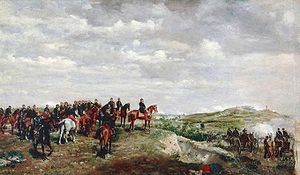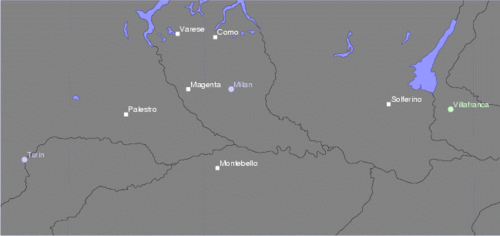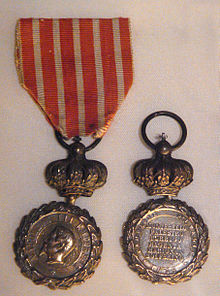- Second Italian War of Independence
-
Second Italian War of Independence Part of the wars of Italian Unification 
Napoleon III at the Battle of Solferino, by Jean-Louis-Ernest Meissonier Oil on canvas, 1863Date April 29, 1859 - July 11, 1859 Location Lombardy-Venetia Result Franco-Sardinian victory
Armistice of Villafranca (July 12, 1859)Territorial
changesLombardy annexed by Sardinia
Sardinia subsequently annexed the central Italian states
France gains Savoy and NiceBelligerents  France
France
 Sardinia
Sardinia Austria
AustriaCommanders and leaders  Napoleon III
Napoleon III
 Victor Emmanuel II
Victor Emmanuel II Ferencz Gyulai
Ferencz Gyulai
 Franz Josef I
Franz Josef IStrength French:
130,000 infantry
2,000 cavalry
312 guns
Sardinian:
70,000 infantry
4,000 cavalry
90 guns220,000 infantry
22,000 cavalry
824 gunsThe Second War of Italian Independence, Franco-Austrian War, Austro-Sardinian War, or Austro-Piedmontese War (also known as the Campaign of Italy, Campagne d'Italie, in France), was fought by Napoleon III of France and the Kingdom of Piedmont-Sardinia against the Austrian Empire in 1859. In respect to the Italian unification process, this war is also known as the Second Independence War.
Contents
Background
The Piedmontese, following their defeat to Austria in the First Italian War of Independence, found that they could not defeat a great power such as Austria without allies. This led Camillo Benso, conte di Cavour to attempt to establish relations with other European powers, partially through Piedmont's participation in the Crimean War. In the peace conference at Paris for the Crimean War, Cavour attempted to bring attention to efforts for Italian unification. He found Britain and France to be sympathetic, but entirely unwilling to go against Austrian wishes, as any movement towards Italian independence would necessarily threaten Austria's territory in Lombardy and Venetia. Individual talks between Napoleon III and Cavour after the conference identified Napoleon as the most likely, albeit still uncommitted, candidate for aiding Italy.
On January 14, 1858, Felice Orsini, an Italian, led an attempt on Napoleon III's life. This assassination attempt brought widespread sympathy for the Italian unification effort, and had a profound effect on Napoleon himself, who now was determined to help Piedmont against Austria in order to end the revolutionary activities that the governments inside Italy might allow to happen in the future. Emperor Napoleon III and Camillo Benso, Conte di Cavour, the prime minister of the Kingdom of Piedmont-Sardinia, signed a secret treaty of alliance against Austria: France would help Sardinia to fight against Austria if attacked, and Sardinia would then give Nice and Savoy to France in return. This secret alliance served both countries: it helped with the Sardinian (Piedmontese) plan of unification of the Italian peninsula under the House of Savoy, and weakened Austria, a fiery adversary of Napoleon III's French Empire.
Cavour, being unable to get the French help unless the Austrians attacked first, provoked Vienna with a series of military manoeuvers close to the border. Austria issued an ultimatum on April 23, 1859, asking for the complete demobilization of the Sardinian army, and when it was not heeded Austria started a war with Sardinia (April 29), thus drawing France into the conflict.
Forces
The French army for the Italian campaign had 130,000 soldiers, 2,000 horsemen and 312 guns, half of the whole French army. The army was under the command of Napoleon III, divided into five corps: the I Corps, led by Achille Baraguey d'Hilliers, the II, led by Patrice MacMahon, the III, led by François Certain Canrobert, the IV, led by Adolphe Niel, and the V, led by prince Napoleon. The Imperial Guard was commanded by Auguste Regnaud de Saint-Jean d'Angély.
The Sardinian army had about 70,000 soldiers, 4,000 horsemen and 90 guns. It was divided into five divisions, led by Casterlbrugo, Manfredo Fanti, Giovanni Durando, Enrico Cialdini, and Domenico Cucchiari. Two volunteers formations, the Cacciatori delle Alpi and the Cacciatori degli Appennini, were also present. The commander in chief was Victor Emmanuel II of Savoy, supported by Alfonso Ferrero la Marmora.
The Austrian army fielded more men: it was composed by 220,000 soldiers, 824 guns and 22,000 horsemen. It was led by Field Marshal Ferencz Graf Gyulai.
The operations
At the declaration of war, there were no French troops in Italy, so Marshal François Certain Canrobert moved in to Piedmont in the first massive use of railways. The Austrian forces counted on a swift victory over the weaker Sardinian army before French forces could arrive in Piedmont. However, Count Gyulai, the commander of the Austrian troops in Lombardy, was very cautious, marching around the Ticino River in no specific direction for a while until eventually crossing it to begin the offensive. Unfortunately for him, very heavy rains began to fall as soon as he did this, allowing the Piedmontese to flood the rice fields in front of his advance, slowing his army's march to a crawl.
The Austrians under Gyulai eventually arrived in Vercelli, menacing Turin, but the Franco-Sardinian move to strengthen Alessandria and Po River bridges around Casale Monferrato forced them to fall back. On May 14, Napoleon III arrived in Alessandria, taking the command of the operations. The initial clash of the war was at Montebello on 20 May, a battle between an Austrian Corps under Stadion against a single division of the French I Corps under Forey. The Austrian contingent was three times as large, but Forey pulled off the victory, making Gyulai even more defensive. In early June, Gyulai was near the rail center of Magenta with the army fairly spread out, and unfortunately caught defending too far east of the river. Napoleon III attacked the Ticino head on with part of his force while sending another large group of troops to the north to flank the Austrians. The plan worked, which led to Gyulai retreating very far to the quadrilateral fortresses in eastern Lombardy, where he was relieved of his post as commander.
Replacing Gyulai was Emperor Franz Josef I himself, feeling up to the simple task of defending the well-fortified Austrian territory behind the Mincio River. He would experience his first and last command at the Battle of Solferino. The Piedmontese-French army had taken Milan and slowly marched further east to finish off Austria in this war before Prussia could get involved. The Austrians found out that the French had halted at Brescia, and decided that they should attempt to surprise them by suddenly switching onto the attack. The French had also gone on the offensive, but neither side was sure of where exactly the other was until they suddenly met. Benedek with the Austrian VIII Corps was separated from the main force, defending Pozzolengo against the Piedmontese part of the opposing army. This they did successfully, though the rest of the Austrian army retreated as soon as a great storm hit, abandoning several towns to the French.
At the same time, in the northern part of Lombardy, the Italian volunteers of Giuseppe Garibaldi's Hunters of the Alps defeated the Austrians at Varese and Como and the Piedmontese-French navy landed 3,000 soldiers and conquered the islands of Lussino (Losinj) and Cherso (Cres) in Dalmatia.
The peace
Fear of involvement by the German states led Napoleon to seek a way out of the war, so he signed an armistice with Austria in Villafranca. Most of Lombardy, with its capital Milan (excepting only the Austrian fortresses of Mantua and Legnago and the surrounding territory), was transferred from Austria to France, which would immediately cede these territories to Sardinia. The rulers of Central Italy, who had been expelled by revolution shortly after the beginning of the war, were to be restored.
This deal, made by Napoleon behind the backs of his Sardinian allies, led to great outrage in Sardinia — Cavour himself resigned in protest. However, the terms of Villafranca were never to come into effect: although they were reaffirmed by the final Treaty of Zürich in November, by then the agreement had become a dead letter. The central Italian states were occupied by the Piedmontese, who showed no willingness to restore the previous rulers, and the French showed no willingness to force them to abide by the terms of the treaty. The Austrians were left to look on in frustration at the French failure to carry out the terms of the treaty.
The next year, in 1860, with French and British approval, the central Italian states — Duchy of Parma, Duchy of Modena, Grand Duchy of Tuscany and the Papal Legations — were annexed by the Kingdom of Sardinia, and France would take its deferred reward, Savoy and Nice. This latter move was vehemently opposed by Italian national hero Garibaldi, a native of Nice, and directly led to Garibaldi's expedition to Sicily, which would complete the preliminary unification of Italy.
Timeline 1859
- 26 May, Giuseppe Garibaldi's Hunters of the Alps confront Austrian forces led by Field Marshal-Lieutenant Carl Baron Urban at Varese;
- 20 May, French infantry and Sardinian cavalry defeat the Austrian army, which retreated, near Montebello;
- 27 May, Hunters of the Alps defeat Urban at San Fermo, entering Como.
- 30 May, Sardinians defeat the Austrian army at the Battle of Palestro;
- 4 June, in the Battle of Magenta, French defeat Austrians;
- June 21/June 24, in the Battle of Solferino, Sardinians and Napoleon III of France defeat an army commanded by Austrian Emperor Franz Joseph himself in northern Italy. The battle inspires Henri Dunant to found the Red Cross;
- July 11, Franz Joseph, faced with the revolution in Hungary, meets Napoleon III at Villafranca, where they signed an armistice.
See also
Categories:- Wars involving Austria
- Wars involving Italy
- Wars involving France
- Conflicts in 1859
- Wars of Italian Independence
- 1859 in Italy
- 1859 in Austria
- 1859 in France
- France–Italy relations
Wikimedia Foundation. 2010.


